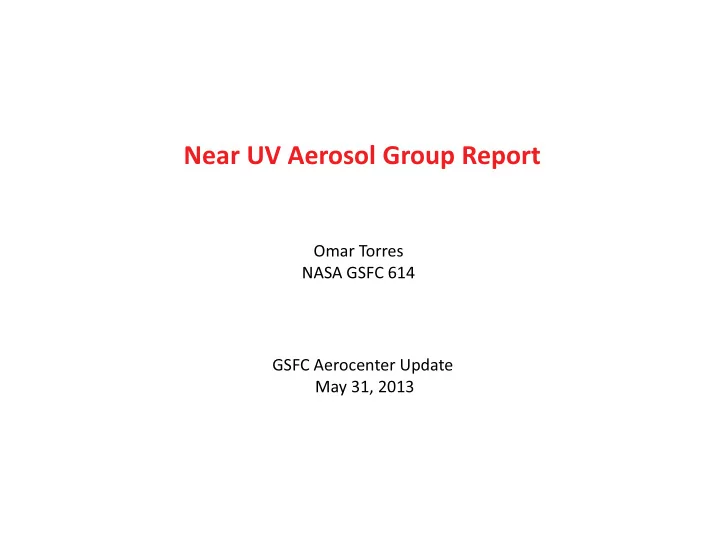

Near UV Aerosol Group Report Omar Torres NASA GSFC 614 GSFC Aerocenter Update May 31, 2013
People Research Group: -Omar Torres (NASA – 614) -Changwoo Ahn (SSAI) -Hiren Jethva (GESTAR-USRA) -Pawan Gupta (GESTAR-USRA) -Santiago Gasso (GESTAR- Morgan State University) -Peter Leonard (ADNET) Collaborations: -PK Bhartia -Nick Krotkov -Mian Chin -Rich McPeters -Peter Colarco, Valentina Aquila (JHU) -E.S. Yang (SSAI) -Sasha Marshak, Jay Herman (UMBC) -Kelly Chance (SAO) -Lorraine Remer (UMBC) -Robert Loughman (HU)
Projects OMI near UV aerosol algorithm and products -Algorithm Upgrades (Ahn, Jethva, Gupta, Torres) -Product Assessment (Ahn, Jethva, Gasso, Torres) -OMI-MODIS Synergy (Gasso, Torres) -Near UV High Spatial resolution (CAI, GLI) Analysis (Gasso, Torres) Detecting Aerosol Above Clouds ( Jethva, Ahn, Torres, Bhartia, Remer) -OMI -MODIS Application -Inter-comparison to other techniques (POLDER, CALIOP) Ground based observations of aerosols (Krotkov, Mok, Jethva, Loughman, Torres, Labow) -Combined use of Cimel and UV and VIS MFRS sensors to measure aerosol absorption Real and spurious effects of stratospheric aerosols on Satellite-measured total ozone (Aquila, Yang, Torres, Bhartia, McPeters, Colarco) MEASURES Near UV Aerosol Project (Torres, Bhartia)
OMAERUV AOD Validation Comparisons at 44 AERONET sites over for years (2005-2008) Non-absorbing aerosol sites All sites Ahn et al., JGR 2013 (submitted); Torres et al., AMT 2013, (submitted)
Single Scattering Albedo Evaluation Comparison to AERONET SSA (440 nm) retrievals Most OMAERUV SSA retrievals agree with AERONET’s within 0.03 in South America, Northern India, NE China, Eastern Saharan Desert, and the Sahel region. Larger differences are observed in Central Saharan, Southern Africa and Southeast Asia. Jethva et al., JGR, 2013 submitted
OMI-MODIS AOD analysis Identification of OMI algorithm and scene specific issues (Santiago Gassó) Algorithm Related issues Cloud Contamination Underestimation of AOD in Overestimation of AOD very dense dust storms in partly cloud About the graphs: (assumed size distribution, conditions Collocated OMI+MODIS+Aeronet pixel (years 04-11) aerosol height) Overlap : OMI AOD corrected by the MODIS AOD Standard : OMAERUV AOD Gasso and Torres (in preparation)
Aerosols Above Clouds: Sensor Inter-comparison (Jethva, Torres, Waquet, Chand) POLDER Aqua-MODIS OMI Aug 13, 2006
Combined use of CIMEL and Modified UV and VIS MFSR Measurements (Krotkov, Torres, Mok, Labow, Jethva, Loughman) UV VIS Inter-calibration: Replace three original UV filters with CIMEL’s Cimel MFSR 340, 380 and 440 nm filters. � � � 440 440 Add a 440 nm CIMEL filter to VIS MFSR sensor Direct Sun measurements: AOD Measure 1 min F diff and F tot (3% error) Sky-radiance measurements Calculate F dir Derive MFSR � uv � vis Particle Size Distribution MFSR � Real Refractive Index uv � vis Mie plus RT Calculations K uv-vis’ SSA uv-vis that explains measured F diff /F tot ratios
CIMEL and Modified UV and VIS MFSR observations: Results Plan to return to Bolivia in 2013 using three-instrument suite
Future Perspective: DSCOVR At Lagrange-1 Deep Space Climate Observatory Earth Seen from L-1 on 12/25/2015 with Jay Herman and Alexander Marshak Lunar Shadow in Northern Hemisphere At L1, the neutral gravity point between the Sun and the Earth, DSCOVR will remain near the same position relative to the Earth and Sun
Earth Polychromatic Imaging Camera Channels and Applications Channel FWHM Spatial Exp. Time � nm) � nm) Purpose Resolution (km) SNR (seconds) 317.5 � 0.1 1 � 0.2 Ozone, SO 2 , UV 10* 265 1.3 325 � 0.1 1 � 0.2 Ozone, UV 10 265 0.84 340 � 0.3 3 � 0.6 Ozone, Aerosols, UV, and Volcanic Ash 10 265 0.13 388 � 0.3 3 � 0.6 Aerosols, Clouds, UV and Volcanic Ash 10 266 0.087 443 � 1 3 � 0.6 Blue, Aerosols, Vegetation 10 265 0.052 551 � 1 3 � 0.6 Green, Aerosols, Vegetation 10 265 0.030 680 � 0.2 2 � 0.4 Red, Aerosol, Veg., O 2 B-Band, Clouds 10 266 0.037 687.75 � 0.2 0.8 � 0.2 O 2 B-Band Cloud Height 10 266 0.060 764.0 � 0.2 1 � 0.2 A-Band Cloud Height 10 265 0.061 779.5 � 0.3 2 � 0.4 A-Band Reference, Vegetation 10 265 0.036 Official launch date: November 2014 Science Team to be selected via ROSES call
Future Perspective (2): Tropospheric Emissions: Monitoring of Pollution (TEMPO) PI: Kelly Chance (Smithsonian Astrophysical Observatory) -First GEO NASA Science Mission -Commercial Satellite Hosted Payload -GEOCAPE Precursor -To be launched in 2019 GEOGRAPHICAL COVERAGE SCIENCE TEAM PLANED PRODUCTS
Recommend
More recommend